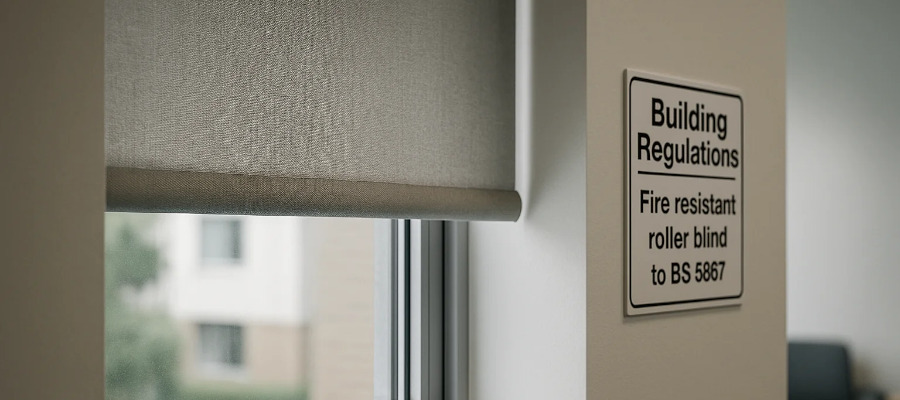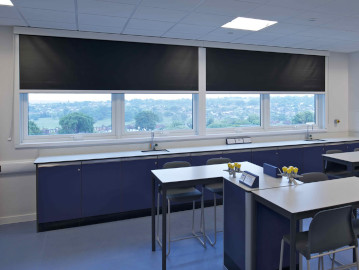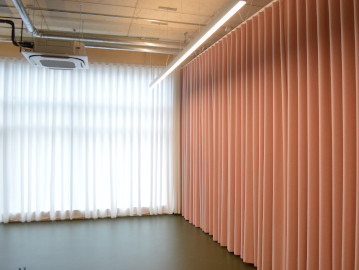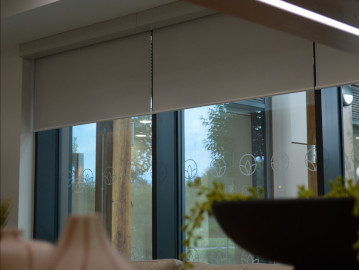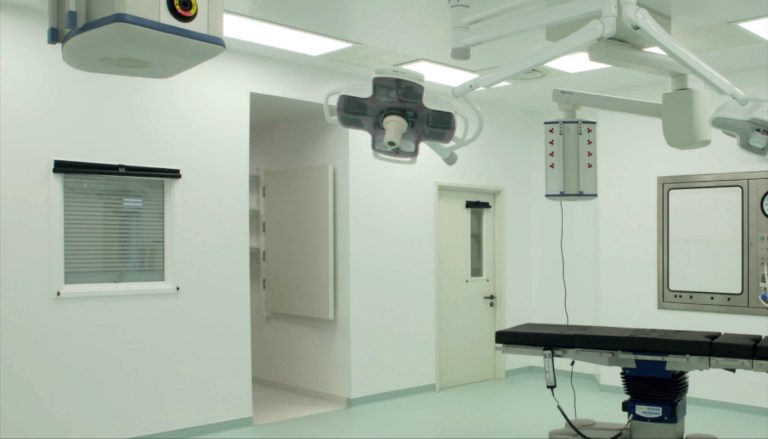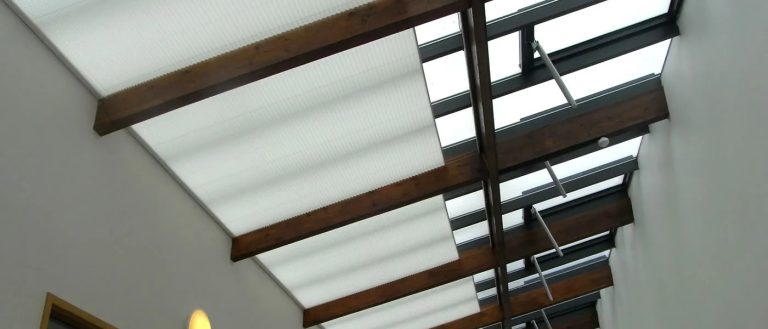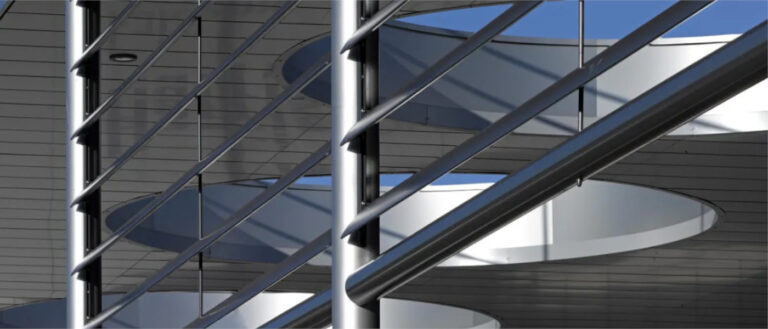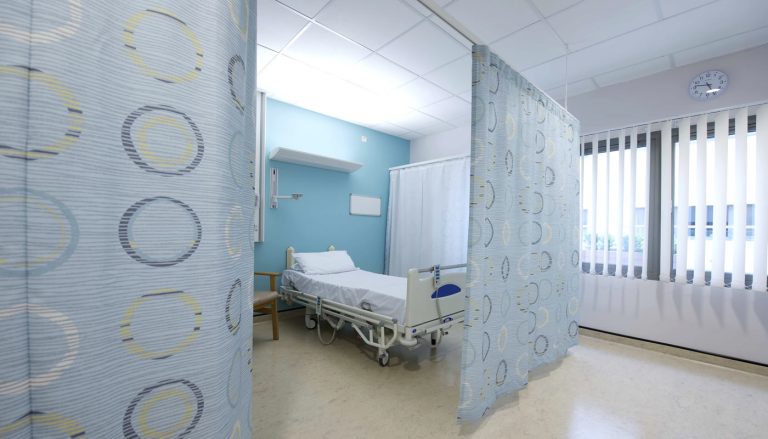Navigating UK Fire Safety Rules for Blinds & Curtains
When you’re responsible for a commercial or public building, fire safety isn’t optional — it’s a legal obligation and a moral one.
The decisions you make around window treatments aren’t just about style or privacy. They can be the difference between a safe escape and a deadly delay.
Yes, regulations matter — especially with the 2025 Part B Building Regulations update tightening the rules around fire resistance, escape windows and materials.
But safety doesn’t have to come at the cost of aesthetics or functionality.
You need both.
At Enviroscreen, we integrate fire safety into all of our window treatments.
From flame-retardant fabrics and certified curtain tracking systems to fully tested fire curtains and blackout blinds, we help you meet the latest standards without sacrificing design.
Our team works with you from initial concept to final installation — making sure everything is safe, compliant and fits seamlessly into your space.
Understanding the Foundational Principles of Fire Safety for Window Treatments
Window treatments might seem harmless, but in a fire, they can either slow down a blaze or accelerate it.
Fabrics that aren’t fire-resistant can ignite quickly, spread flames across walls or ceilings and release toxic smoke — all while blocking critical escape routes.
Let’s put this into perspective:
- 41% of all fire-related fatalities in England in 2023 happened in homes that lacked adequate fire safety measures.
- You’ve got less than 3 minutes on average to escape a house fire once it starts.
Fire-resistant curtains, blinds and shutters buy you time by holding back the spread of flames and maintaining safe egress points.
In healthcare settings, schools and high-rise buildings, this becomes even more critical.
Defining Key Terminology and Concepts
Here’s a quick cheat sheet to help you cut through the jargon:
| Term | Meaning |
|---|---|
| Fire Retardant | A material treated to resist ignition but may still burn slowly. |
| Fire Resistant | A material designed to withstand fire for a set duration without failure. |
| Fire Rated | A certified product that has passed fire safety testing for a specified time. |
| Compartmentation | The use of barriers (e.g. fire curtains) to contain fire within a defined area. |
| Means of Escape | Designated, accessible routes that occupants can use to exit during a fire. |
| Integrity | The ability of a barrier to prevent flames and hot gases passing through. |
| Insulation | The ability of a barrier to prevent heat transmission from one side to another. |
Integrity vs Insulation:
You’ll often see these terms in product certifications.
Integrity is about stopping fire from getting through; Insulation is about stopping the heat.
For example, a curtain with 60 minutes of integrity and 30 minutes of insulation holds the fire back for an hour, but only keeps the heat at bay for half that time.
When specifying products, it’s vital to match both ratings to your building’s fire strategy. We’ll help you choose exactly what your site needs — no more, no less.
The Historical Evolution of UK Fire Safety Regulations for Window Treatments
It’s only in the past few decades that fire safety for window treatments has really been taken seriously.
In older commercial and public buildings, curtains and blinds were often installed without any consideration for how they’d behave in a fire.
Flammable textiles became unintentional fuel — especially in schools, theatres and care homes.
Early attempts at regulation were patchy at best. Standards existed, but they weren’t comprehensive, and compliance was often voluntary or poorly enforced.
Fabrics were rarely tested beyond basic flame resistance, and many installations lacked proper documentation or risk assessment.
The Regulatory Reform (Fire Safety) Order 2005 and its Impact:
Everything changed in 2005.
The Regulatory Reform (Fire Safety) Order created a single, unified law covering fire safety in non-domestic premises across England and Wales.
For the first time, the responsibility for compliance shifted squarely onto the shoulders of building owners, facilities managers and operators.
Key changes introduced:
- You’re legally required to carry out a fire risk assessment that includes all soft furnishings — including curtains and blinds.
- Hotels, schools, hospitals and care homes must use certified fire-resistant materials for window treatments.
- Ongoing inspection and maintenance became mandatory to ensure long-term performance.
This legislation paved the way for clearer, more enforceable rules — but it also raised the bar.
If you manage a public or commercial building, you’re now expected to understand and prove that your window treatments meet fire safety standards.
At Enviroscreen, we work with you to stay on the right side of the law.
We provide products that meet or exceed BS 5867 and other relevant standards, and we support your fire safety documentation with all the certifications you need.
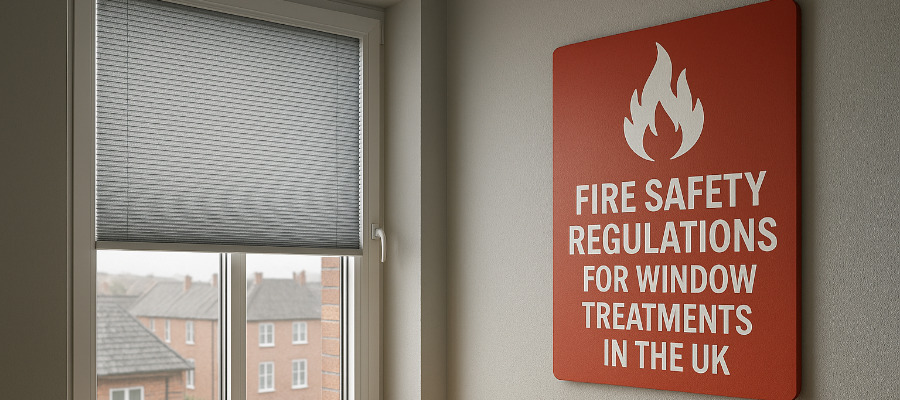
Navigating the Current UK Regulatory Framework for Window Treatments
When you’re updating or replacing windows in a commercial or public building, you’ll be dealing with a set of tightly defined rules under the Building Regulations.
Windows and external doors are classed as “controlled fittings”, meaning they must comply with specific requirements that affect multiple areas of building performance:
Key areas affected:
- Thermal performance – Meeting U-value targets to limit energy loss
- Safety – Including glazing type and protection from impact
- Air supply – Ensuring adequate ventilation, especially in habitable spaces
- Means of escape – Guaranteeing that windows don’t obstruct emergency exits
- Ventilation – In some cases, windows are integral to a building’s fresh air system
If you’re fitting new blinds, curtains or shading systems during a window replacement, those too must complement — not compromise — these functions.
Part B Building Regulations and the 2025 Update:
Part B of the Building Regulations covers fire safety, and it’s where things get serious for window treatments.
The 2025 update raises the bar for residential settings — but don’t assume it only affects homes.
These rules impact any space where residential and commercial environments overlap, such as hotels, care homes or mixed-use developments with public-facing areas.
What’s changed in 2025?
| Requirement | New Mandate (2025) |
|---|---|
| Fire-resistant glazing | Must withstand fire for 30 minutes in critical areas |
| Escape windows (residential use) | Min. 0.33m² opening, 450mm height min (first floor) |
| Fire-resistant coatings | Needed on window frames in high-risk zones |
| Windows near boundaries | Must meet enhanced fire resistance if within 1m |
These updates aim to reduce fire spread between properties and improve occupant escape time — particularly relevant for dense urban builds and multi-occupancy buildings.
If you’re involved in façade design or internal partitions in public-facing properties, you’ll need to take note.
We’ll help you stay ahead.
Our fire-rated window treatments, including customisable fire curtains and intumescent-enhanced roller systems, are already designed with these updates in mind.
Understanding Product-Specific Standards: BS 5867 and Beyond:
Several British and European standards govern how different window treatments perform under fire conditions.
Here’s a snapshot of the most relevant ones:
| Standard | Applies To | What It Covers |
|---|---|---|
| BS 5867 Part 2 | Curtains and drapes | Fire retardancy in commercial/public buildings. Requires certified flame spread control. |
| BS 8524 | Fire curtain barrier assemblies | Full performance testing and approval for fire curtain systems |
| BS EN 16034 | Pedestrian doors, windows and curtain walls | Fire resistance and smoke control in glazed systems |
| BS EN 1634-1 | Fire resistance testing | Fire testing of door and shutter assemblies (including fire curtains) |
If you’re specifying shading or curtains for hospitals, schools or hospitality spaces, BS 5867 Part 2 Type B or C is often the baseline requirement.
But if you’re using active fire curtain systems, BS 8524 and EN 16034 apply — and your product must be tested accordingly.
The Dual Regulations: BS 476 vs. EN 1634-1
Here’s where things can get confusing.
The UK is currently working within a dual standard system. Some fire safety products are still tested to the older BS 476, while others now use the more comprehensive European EN 1634-1.
So what’s the difference?
BS 476 focuses mainly on flame spread and structural integrity during a fire, but doesn’t always assess insulation performance. EN 1634-1, on the other hand, tests for integrity, insulation and smoke control — offering a fuller picture of how a product behaves under fire conditions.
BS 476 was developed in the UK and is still valid for some applications, particularly in certain retrofit scenarios. EN 1634-1 was developed by the European Committee for Standardisation and is now recognised across the EU and still used in the UK post-Brexit.
The challenge? Both are still in play.
That means you need to know which standard applies to your project, your building type and your intended fire strategy. When in doubt, EN 1634-1 is widely considered the stronger benchmark — and the direction most regulatory bodies are heading.
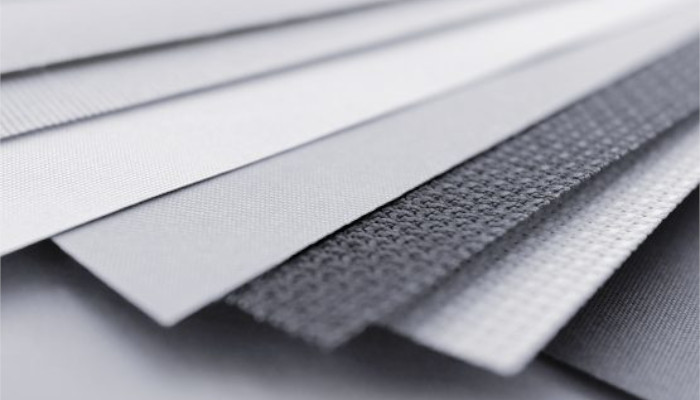
Ensuring Compliance and Navigating Enforcement Mechanisms
If you own or manage a commercial or public building, you’re legally responsible for ensuring the fire safety of window treatments.
That responsibility includes:
- Carrying out a fire risk assessment that covers all fabric-based fittings like blinds and curtains
- Including window treatments in your fire safety strategy and evacuation plan
- Ensuring that all products meet the appropriate fire-resistance standards and are installed by competent professionals
- Keeping up-to-date documentation for compliance, inspections and insurance purposes
These duties aren’t just box-ticking exercises — they’re vital to protect occupants and avoid legal exposure.
Achieving Compliance During Window Replacement and Installation:
There are two routes to achieve compliance when replacing windows or installing new window treatments:
- Use a Competent Person Scheme Installer These professionals are registered under government-approved schemes and can self-certify that their work meets Building Regulations. You’ll receive a certificate of compliance, which satisfies legal and insurance requirements.
- Apply to a Building Control Body (BCB) You can also seek approval through your local authority or a private approved inspector. The BCB will assess the work before, during or after installation to confirm compliance.
Whichever route you choose, you must obtain and retain certification. This could include:
- Product test reports and fire ratings (e.g. BS 5867 or BS 8524)
- Installer certifications
- Maintenance and inspection logs
Consequences of Non-Compliance: Legal and Financial Implications:
Failing to meet fire safety regulations comes with real consequences.
- Legal penalties may include enforcement notices, fines, or even prosecution under the Regulatory Reform (Fire Safety) Order
- Insurance claims can be reduced or denied if non-compliance is discovered after an incident
- Delays in property transactions are common when documentation is incomplete or window treatments don’t meet required standards
- You may also face increased premiums if fire safety compliance can’t be demonstrated
Compliance protects more than just the building — it protects your liability and your reputation.
Real-World Applications: Case Studies in Fire-Safe Window Treatments
Implementing Fire Curtain Systems in Care Facilities (Bluebell Park)
At Bluebell Park Residential Care Facility, fire safety needed to work hand-in-hand with accessibility and aesthetics. The solution included:
- Four FCe60-rated fire curtains providing 60 minutes of integrity
- An integrated FRS60 fire shutter for additional protection
- Systems designed to compartmentalise fire zones and protect vulnerable occupants during delayed evacuation scenarios
This installation not only met regulatory requirements — it addressed real-life challenges of mobility and delayed response time in a care setting.
Large-Scale Fire Safety Integration in High-Rise Buildings (100 Bishopsgate)
This prominent commercial tower in London required both scale and subtlety. The team installed:
- 106 FCe30 fire curtain systems, each rated for 30 minutes of flame resistance
- Custom satin-finished stainless-steel fixtures, maintaining architectural elegance
- Seamless integration with the building’s wider fire safety strategy, ensuring barriers would deploy without interrupting circulation
The result was a system that balanced high-spec fire safety with visual and functional demands.
Achieving Fire Safety with Sash Windows
Sash windows in residential settings — particularly in period or conservation areas — pose a unique challenge.
Meeting fire safety requirements without compromising design involves:
- Using 30-minute fire-resistant glass in designated risk areas
- Ensuring escape windows meet minimum size (0.33m²) and height (450mm)
- Applying intumescent seals and fire-resistant coatings to timber frames
With these elements in place, buildings can preserve their traditional character while still complying with Part B of the Building Regulations — a balancing act that’s increasingly expected in planning approvals.
Expert Insights and Industry Consensus on Window Treatment Fire Safety
Window treatments aren’t standalone safety devices — they form part of a wider strategy.
They must work in concert with compartmentation zones, escape planning, ventilation, alarms and sprinklers.
Fire barriers that fail in one area can compromise the rest of the building, which is why consistency and coordination matter.
The Value of Third-Party Certification and Testing:
Certified products give you certainty.
Third-party testing ensures that fire-resistant claims are verified, not just marketing.
Certification also simplifies compliance, inspection and insurance processes. Look for BS or EN markings and ensure that documentation is available before specifying any system.
Defining Responsibilities: Owners, Operators, and Fire Services:
Fire safety isn’t the responsibility of just one party — it’s a shared duty.
- Owners and managers must specify compliant products and maintain them
- Installers must ensure proper fit and function
- Fire services can provide local guidance and audit support
Collaboration between these roles improves safety outcomes and avoids critical oversights.
The Necessity of Regular Inspection and Maintenance
Even the most advanced fire-resistant systems degrade over time.
Fabric coatings can wear, seals can loosen, and mechanical parts can fail. Regular inspection is essential — particularly in high-traffic, public-facing buildings.
In general, window treatments should be checked annually or according to the manufacturer’s recommendations.
Documentation of inspections and repairs should also be maintained.
Fire Curtains as a Critical Architectural Solution:
Fire curtains have become a preferred option in modern architecture — especially in open-plan environments where traditional fire doors aren’t viable.
They offer:
- Space-saving alternatives to permanent barriers
- Design flexibility, retracting when not in use
- Compliance with fire compartmentation strategies, especially in large atriums or lobbies
When specified correctly and installed to standard, they offer high performance without compromising on design.
Addressing Conflicting Viewpoints and Navigating Potential Challenges
While EN 1634-1 is now preferred, many legacy systems and projects still reference BS 476.
The overlap complicates specification and approval, particularly where older products are still in use.
Professionals should:
- Check with local Building Control for standard acceptance
- Choose EN 1634-1 products where possible
- Ensure all documentation clearly states the testing protocol used
Balancing Heritage Conservation and Modern Fire Safety Demands:
Older buildings often pose a conflict between conservation and compliance.
Traditional window styles, original timber frames and listed status can make full compliance with modern fire standards difficult.
In these cases, alternatives like:
- Intumescent glazing
- Retrofitted fire-resistant linings
- Discrete fire curtains
…can offer a practical compromise, meeting safety goals while preserving character.
Overcoming the Knowledge Gap in Regulatory Implementation:
The complexity of fire safety regulations creates a knowledge gap — not everyone involved in a project will fully understand the latest updates or testing protocols.
This can lead to inconsistent application and missed requirements.
To address this:
- Encourage training and CPD for specifiers and facilities teams
- Use manufacturers and fire consultants as knowledge resources
- Ensure clear documentation across the supply chain
Staying informed is as important as selecting the right products.
Practical Guidance for Architects and Interior Designers
Regulations are unlikely to stand still.
The pattern is clear — each update brings tighter rules, more precise definitions and a broader scope of accountability.
Expect future changes to:
- Expand the list of materials subject to fire resistance testing
- Increase performance thresholds in escape routes and boundary-adjacent windows
- Include emerging risks linked to new construction methods (like modular builds or timber-frame high-rises)
- Demand more stringent fire testing for retrofit and refurbishment projects, not just new builds
As the understanding of fire behaviour improves, so too will the requirements. Particularly where vulnerable groups or dense occupancy are involved.
The Impact of Technological Innovation on Fire-Safe Window Treatments
Technology is set to reshape how fire safety is managed and integrated.
Key developments on the horizon include:
- Smart fire curtains that automatically deploy when triggered by smoke or heat detection systems
- Integrated systems linking window treatments to central building management or alarm systems
- New-generation fabrics and coatings offering higher fire resistance while remaining thin, lightweight and sustainable
- Digitally traceable components with built-in QR codes or RFID for maintenance tracking and compliance logging
These advances won’t just improve performance — they’ll make ongoing compliance easier to monitor and prove.
Integrating Sustainability with Fire Safety in Window Treatment Design
The construction industry is under pressure to balance safety with sustainability. This applies to window treatments too.
We’re seeing a shift towards:
- Eco-friendly fire-retardant fabrics, free from halogens or harmful additives
- Life-cycle assessments of window systems, factoring in production, installation and disposal
- Recyclable fire curtain components, like aluminium housings or low-emission coatings
- Multi-functional systems that combine thermal control, glare reduction and fire safety
Future-ready designs will be those that perform across the board, not just in a fire, but across energy, comfort and sustainability metrics.
Some key tips:
- Start early: Fire performance should be considered from concept stage, not post-spec
- Engage Building Control: Bring compliance officers into the process before finalising materials
- Use mock-ups: Test aesthetics and performance side by side, especially in visible areas
- Balance priorities: Consider fire safety alongside acoustics, thermal performance, accessibility and cost
With the right approach, compliance doesn’t have to mean compromise.
Implementing Effective Design Strategies for Fire-Safe Window Treatments
It pays to stay proactive.
- Keep learning: Stay up to date on fire safety regulations and how they apply to your project types
- Build supplier relationships: Partner with vendors who offer compliant products and documentation
- Collaborate with fire consultants: Especially on complex buildings or heritage retrofits
- Document everything: Keep records of product certifications, installation details and maintenance guidance
These habits reduce friction at inspection and handover — and protect your reputation.
Key Considerations When Selecting Window Treatments for Fire Safety
Here’s a practical checklist for selecting compliant, effective and visually appropriate solutions:
| Consideration | Key Question |
|---|---|
| Location | Is the window near an escape route, stairwell or property boundary? |
| Occupancy | Will vulnerable users (e.g. children, patients, elderly) be present in the space? |
| Operation | Is the window treatment manual, motorised or automated — and how does it function in an emergency? |
| Compliance | Does the product meet relevant standards like BS 5867, BS 8524 or EN 1634-1? |
| Maintenance | Can it be easily inspected, cleaned and serviced over time? |
| Design Intent | Will the fire safety features integrate with the overall aesthetic and design goals? |
Make these considerations part of your specification routine.
Actionable Recommendations for Stakeholders
Recommendations for Property Owners and Managers
- Conduct comprehensive assessments Evaluate all window treatments for fire compliance, especially those near escape routes or boundaries.
- Use qualified professionals Only use installers registered with a recognised Competent Person Scheme to ensure proper certification.
- Maintain documentation Keep up-to-date records of certifications, test results and maintenance logs for insurance and compliance audits.
- Implement regular inspections Establish and follow a maintenance schedule to ensure ongoing fire resistance.
Recommendations for Manufacturers and Suppliers
- Pursue rigorous certification Ensure products are tested and compliant with the latest standards and offer clear, traceable documentation.
- Provide transparent information Make it easy for clients to access fire ratings, testing data and installation guidelines.
- Invest in innovation Develop products that go beyond basic compliance — combining fire safety, design, and environmental performance.
- Support specifiers Offer training and technical advice to architects and contractors to ensure proper application.
Recommendations for Regulatory Bodies and Industry Organisations
- Enhance guidance materials Create sector-specific resources that make fire safety requirements clearer and more accessible.
- Support standards harmonisation Work towards greater alignment between British and European standards to reduce duplication.
- Promote research Fund research into new materials, fire behaviour and risk scenarios relevant to modern construction.
- Facilitate knowledge sharing Encourage collaboration through events, case studies and cross-sector initiatives.

Conclusion: Ensuring a Safer Future Through Compliant Window Treatments
Fire safety in commercial and public buildings is more than just a regulatory hurdle — it’s a critical part of building design, risk management and occupant protection.
Window treatments may seem minor in the wider scheme of building safety, but as you’ve seen, their role is anything but.
From compliance with Part B and product-specific standards like BS 5867, to navigating dual testing systems and managing design integration, the requirements are detailed, technical and ever-changing.
Getting it right takes more than a compliant product.
It requires collaboration between architects, specifiers, building managers, fire engineers and manufacturers.
No single decision happens in isolation. The best results come when everyone’s working from the same playbook, towards the same goal.
And that’s where we come in.
We help you make sense of it all. We supply tested, certified and fully documented fire-safe blinds, curtains and shading systems — tailored to your building’s needs, use and visual design.
Our support doesn’t stop at the product. We advise on early-stage design, coordinate with installers and provide the documentation you need to stay compliant and confident.
As regulations evolve, so do we — staying ahead of new standards, emerging risks and sustainable innovation, so you don’t have to worry about falling behind.
Let’s build safer spaces together.
Fire Safety and Window Treatments – FAQs
1. Do all curtains and blinds in public buildings need to be fire-resistant?
Yes. In commercial and public spaces — including schools, hospitals, hotels and care homes — window treatments must meet minimum fire-resistance standards such as BS 5867 Part 2.
2. What’s the difference between flame retardant and fire resistant?
Flame retardant materials slow ignition but may still burn. Fire-resistant materials are tested to withstand fire exposure for a specific time and prevent flame or heat transfer.
3. Can fire-safe window treatments still look good?
Absolutely. Many modern fire-rated fabrics and systems are available in a wide range of finishes and colours, with customisation options to suit your design goals.
4. What documentation do I need for compliance?
You’ll typically need third-party test certificates, installation records and ongoing maintenance logs — especially if you’re managing inspections or fire risk assessments.
5. How often should fire-resistant window treatments be inspected?
A minimum of once per year is a good rule of thumb, though some high-risk environments may require more frequent checks.
6. Who’s responsible for ensuring compliance?
Ultimately, building owners and operators are responsible. However, everyone in the project chain — from designers to installers — plays a part.
For enquiries about fire safety solutions:
Enviroscreen Systems
Swift House,
13 Ronsons Way,
St Albans,
AL4 9QT
United Kingdom
Telephone: 01727 220 007
E-mail: info@enviroscreen.org.uk

